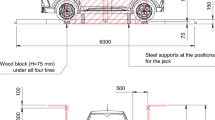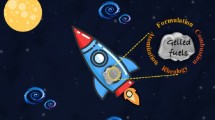Abstract
A series of experimental investigations is performed for determining the thermal and environmental characteristics of burning heavy fuel oil of the M-100 type sprayed by a jet of superheated steam in a laboratory prototype of a new burner. A scheme of liquid fuel burning preventing choking of narrow fuel channels of injectors is proposed; this scheme ensures effective burning of high-viscosity fuels and wastes. The process of stable burning of heavy fuel oil in a low-power (7 kW) burner with low concentrations of toxic emissions and high combustion efficiency is realized.
Similar content being viewed by others
References
Heating Oil Explained (U.S. Energy Inform. Administr., Washington, 2019); https://www.eia.gov/energyexplained/heating-oil/use-of-heating-oil.php.
Oil: Crude and Petroleum Products Explained (U.S. Energy Inform. Administr., Washington, 2019); https://www.eia.gov/energyexplained/oil-and-petroleum-products/use-of-oil.php.
A. G. Abdul Jameel, Y. Han, O. Brignoli, et al. “Heavy Fuel Oil Pyrolysis and Combustion: Kinetics and Evolved Gases Investigated by TGA-FTIR,” J. Anal. Appl. Pyrolysis. 127, 183–195 (2017); DOI: https://doi.org/10.1016/j.jaap.2017.08.008.
J. Barroso, F. Barreras, and J. Ballester, “Behavior of a High-Capacity Steam Boiler Using Heavy Fuel Oil. Pt 1. High-Temperature Corrosion,” Fuel Process. Technol. 86 (2), 89–105 (2004); DOI: https://doi.org/10.1016/j.fuproc.2003.12.006.
H. L. Goldstein and C. W. Siegmund, “Influence of Heavy Fuel Oil Composition and Boiler Combustion Conditions on Particulate Emissions,” Environment. Sci. Technol. 10 (12), 1109–1114 (1976); DOI: https://doi.org/10.1021/es60122a006.
O. Sippula, J. Hokkinen, H. Puustinen, et al., “Comparison of Particle Emissions from Small Heavy Fuel Oil and Wood-Fired Boilers,” Atmospher. Environment. 43 (32), 855–4864 (2009); DOI: https://doi.org/10.1016/j.atmosenv.2009.07.022.
A. G. Tumanovskii, V. I. Babii, Yu. P. Enyakin, et al., “Improvement of Fuel Burning Technologies,” Teploenergetika, No. 7, 30–39 (1996); https://elibrary.ru/item.asp?id=15055485.
P. Mikaniki, S. M. A. Najafi, and H. Ghassemi, “Experimental Study of a Heavy Fuel Oil Atomization by Pressure-Swirl Injector in the Application of Entrained Flow Gasifier,” Chinese J. Chem. Eng. 27 (4), 765–771 (2019); DOI: https://doi.org/10.1016/j.cjche.2018.10.001.
V. B. Garaniya, “Modelling of Heavy Fuel Oil Spray Combustion Using Continuous Thermodynamics,” Ph. D. Thesis [Univ. Tasmania (Australian Maritime College), Newnham, 2009].
D. R. Schneider and Z. Bogdan, “Effect of Heavy Fuel Oil/Natural Gas Co-Combustion on Pollutant Generation in Retrofitted Power Plant,” Appl. Thermal Eng. 27 (11/12), 1944–1950 (2007); DOI: https://doi.org/10.1016/j.applthermaleng.2006.12.017.
F. Miccio and F. M. Okasha, “Fluidized Bed Combustion and Desulfurization of a Heavy Liquid Fuel,” Chem. Eng. J. 105 (3), 81–89 (2005); DOI: https://doi.org/10.1016/j.cej.2004.10.001.
M. S. B. Khaleghi and R. S. Markadeh, “Thermodynamic Evaluation of Mazut Gasification for Using in Power Generation,” Petrol. Sci. Technol. 34 (6), 531–538 (2016); DOI: https://doi.org/10.1080/10916466.2016.1149491.
S. Kouravand and A. M. Kermani, “Clean Power Production by Simultaneous Reduction of NOx and SOx Contaminants Using Mazut Nano-Emulsion and Wet Flue Gas Desulfurization,” J. Cleaner Product. 201, 229–235 (2018); DOI: https://doi.org/10.1016/j.jclepro.2018.08.017.
A. Alahmer, J. Yamin, A. Sakhrieh, and M. A. Hamdan, “Engine Performance Using Emulsified Diesel Fuel,” Energy Conv. Manag. 51, 1708–1713 (2010); DOI: https://doi.org/10.1016/j.enconman.2009.11.044.
K. Kannan and M. Udayakumar, “NOx and HC Emission Control Using Water Emulsified Diesel in Single Cylinder Diesel Engine,” J. Eng. Appl. Sci. 4, 59–62 (2009).
G. E. Andrews, S. W. Bartle, S. W. Pang, et al., “Diesel/Water Emulsions. Influence on Ignition Delay and Emissions,” in Proc. of the Int. Centre for Heat and Mass Transfer (Taylor and Francis, 1989), pp. 613–625.
M. T. Jacques, J. B. Jordan, A. Williams, and L. Hadley-Coates, “The Combustion of Water-in-Oil Emulsions and the Influence of Asphaltene Content,” Symp. (Int.) Combust. 16 (1), 307–319; DOI: https://doi.org/10.1016/S0082-0784(77)80334-2.
M. Ballester, N. Fueyo, and C. Dopazo, “Combustion Characteristics of Heavy Oil-Water Emulsions,” Fuel 75, 695–705 (1996); DOI: https://doi.org/10.1016/0016-2361(95)00309-6.
A. Parlak, V. Ayhan, and Y. Üst, “New Method to Reduce NOx Emissions of Diesel Engines: Electronically Controlled Steam Injection System,” J. Energy Inst. 85 (3), 135–139 (2012).
A. Farokhipour, E. Hamidpour, and E. Amani, “A Numerical Study of NOx Reduction by Water Spray Injection in Gas Turbine Combustion Chambers,” Fuel 212, 173–186 (2018); DOI: https://doi.org/10.1016/j.fuel.2017.10.033.
M. S. Vigriyanov, V. V. Salomatov, and S. V. Alekseenko, “Method of Sootless Combustion of Fuel,” RF Patent No. RU2219435, MKI F 23 D 5/00, F 23 C 99/00, F 23 L 7/00, Publ. 20.12.2003.
I. S. Anufriev, S. V. Alekseenko, O. V. Sharypov, and E. P. Kopyev, “Diesel Fuel Combustion in a Direct-Flow Evaporative Burner with Superheated Steam Supply,” Fuel 254, 115723 (2019); DOI: https://doi.org/10.1016/j.fuel.2019.115723.
I. S. Anufriev and E. P. Kopyev, “Diesel Fuel Combustion by Spraying in a Superheated Steam Jet,” Fuel Process. Technol. 192, 154–169 (2019); DOI: https://doi.org/10.1016/j.fuproc.2019.04.02742.
I. S. Anufriev, S. V. Alekseenko, E. P. Kopyev, and O. V. Sharypov, “Combustion of Substandard Liquid Hydrocarbons in Atmosphere Burners with Steam Gasification,” J. Eng. Thermophys. 28 (3), 1–8 (2019); DOI: https://doi.org/10.1134/S1810232819030032.
I. S. Anufriev, M. S. Vigriyanov, S. V. Alekseenko, et al., “Steam-Oil Burner,” RF Patent No. RU2684300, MKI F 23 D 5/04, F 23 L 7/00, Publ. 05.04.2019.
M. S. Vigriyanov, I. S. Anufriev, E. P. Kopyev, et al., “Burner,” RF Patent No. RU2647172, MKI F 23 L 7/00, F 23 D 11/20, F 23 C 99/00, Publ. 14.03.2018.
“Catalog of Unique Scientific Setups,” http://ckp-rf.ru/usu/73570.
“Automatic Forced Draught Burners for Liquid Fuels,” Standard DIN EN 267:2011-11 (German Institute for Standardisation, Publ. 01.01.2011).
Author information
Authors and Affiliations
Corresponding author
Additional information
This work was supported by the Russian Science Foundation (Grant No. 18-79-10134).
Original Russian Text © S.V. Alekseenko, I.S. Anufriev, M.S. Vigriyanov, E.P. Kopyev, I.S. Sadkin, O.V. Sharypov.
__________
Translated from Prikladnaya Mekhanika i Tekhnicheskaya Fizika, Vol. 61, No. 3, pp. 11–18, May–June, 2020.
Rights and permissions
About this article
Cite this article
Alekseenko, S.V., Anufriev, I.S., Vigriyanov, M.S. et al. Burning of Heavy Fuel Oil in a Steam Jet in a New Burner. J Appl Mech Tech Phy 61, 324–330 (2020). https://doi.org/10.1134/S0021894420030025
Received:
Revised:
Accepted:
Published:
Issue Date:
DOI: https://doi.org/10.1134/S0021894420030025




